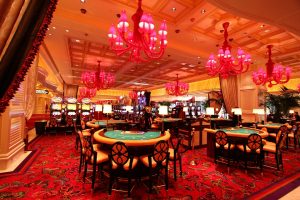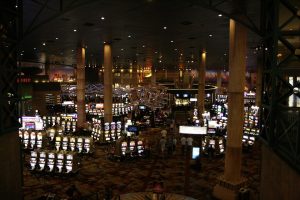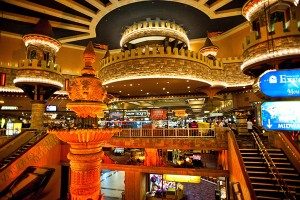Casinos represent some of the most impressive architecture of any public building. People who go into casinos often find they’re lost in a huge maze of slot machines, card tables, and sexy waitresses carrying drinks.
Of course, if you’re visiting a casino, the chances are you are going to be overwhelmed by the entire experience – the noise, the lights, the sights — and your first thought certainly won’t be about how its designers have subtly created the gaming experience for you to enjoy.
Yet, while most people just accept casinos at face value, there is a lot more that goes into the designing of a casino than you might think. Casino design has long been an art form, and the layout of their interiors has evolved over time as more interesting and innovative ways have been developed to encourage punters to gamble more while also having a lot of fun doing it.

Serving All Types of Players
 Modern casino design guidelines consider casinos need to serve the needs of a wide variety of people. Thousands of players may visit on any given day. Some are confused and impressionable beginners and others are high rollers who have visited more casinos than they’ve had hot dinners.
Modern casino design guidelines consider casinos need to serve the needs of a wide variety of people. Thousands of players may visit on any given day. Some are confused and impressionable beginners and others are high rollers who have visited more casinos than they’ve had hot dinners.
When designing a casino, it’s important that designers look at all the customers who could be attracted to their establishment and come up with a design that works for everyone.
There are three main kinds of customers who use land-based casinos: High rollers, casual gamers, and hotel guests. Each will use the casino differently.
• High rollers ignore distractions, such as slot machines, and head straight to the gaming tables.
• Casual gamers to prefer slots.
• Hotel guests are often just passing through the gaming floor as they head up to their bedroom but may stop to play for a while before moving on.
It is important all these primary customer types are well catered for in the casino design so punters don’t go elsewhere and take their business with them.
Important Elements to Consider
 When designing a casino, there are numerous variables that must be borne in mind. First, it’s important to consider what is visible over the slot machines. It also vital to consider which areas crowds prefer to gather in while paying attention to aromas and ambient noise.
When designing a casino, there are numerous variables that must be borne in mind. First, it’s important to consider what is visible over the slot machines. It also vital to consider which areas crowds prefer to gather in while paying attention to aromas and ambient noise.
Even these small details are key to the success of a casino design. Women, for example, have been shown to feel more comfortable to gamble in areas with fewer crowds and may be deterred from using the gaming tables if they feel they are being watched.
Casino designers plan out the main routes that each customer type will take during his or her time on the casino floor. They then tweak that map, so they can create as much appeal as possible for every customer.
This allows the hotel guests to encounter a range of exciting games on their way to the elevator up to their room, and this may entice them to return and play. Casual gamers coming in from the street will immediately see the biggest and best slots titles without having to search for them.
Casino designers can then work on designing a floor that persuades customers to continue venturing into the heart of the casino, instead of heading toward the exit.
The Maze Layout
Until the early part of the 2000s, designers tended to use a design layout popularly known as a “maze.” The idea behind this concept was the casino floor should rapidly suck the player in, making it hard to get away.
It is this design that led to the idea there are no windows and clocks in Las Vegas casinos so players can remain confused about what time it really is and how long they’ve been gambling.
The maze layout is especially clear on the gaming floor, with the slots being arranged in arcs rather than in rows like they were during the 1960s. This means that players who enter this area need to spend quite some time working their way out, and may well decide to play a few extra games on the way.
The primary principle of the maze layout is all exits should be hidden through signage and a player should always be able to see a wide range of tables or gaming machines regardless of where he or she stands on the gaming floor.
Modern Casino Design

As 2010 approached, casino layouts began to get an overhaul, with high-class establishments, such as the Wynn and the Bellagio, switching low ceilings for high ones and the maze layout for smaller groupings of slot machines with larger open spaces surrounding them. Players who entered the casino would no longer see slots. Instead, there would be sunlight, sculptures, and attractive wide avenues that led to the tables.
The name of this modern design concept is the “playground,” with the principles behind it being to turn casinos from a confusing and worrying place into a luxurious palace in which players would feel excited and comfortable in opulent surroundings.
This latest design has shown itself to be very successful at persuading all kinds of players to part with their money. And, because they are more comfortable, they will show greater understanding if they lose and are happier if they win. In all cases, this makes them willing to wager more.
Slot Machine and Table Layouts
 During the 1970s, slots were only responsible for earning around 40 percent of average casino revenue. That number, however, has increased by 71 percent today, with more players than ever preferring to use slots than tables.
During the 1970s, slots were only responsible for earning around 40 percent of average casino revenue. That number, however, has increased by 71 percent today, with more players than ever preferring to use slots than tables.
The small groups of machines that are now popular have meant that punters are able to see plenty of games no matter where they stand, giving them plenty of options and choice. The grouping arrangement also ensures a more sociable gameplay experience. People who are visiting in groups can also enjoy a more fun experience because they play in a circle together.
Traditionally, table games are laid out in the center of the gaming floor so they can be more easily secured and managed. The good news for casino designers is regular players will always head to the tables no matter where they are, so placement isn’t too critical anyway. The central location of these games does have another advantage though.
As crowds become noisy, especially when a player is on a winning streak, the energy in the whole room rises, encouraging new players to join in. When gaming tables are popular, more players will also be encouraged to come and join in. Busier tables always attract more punters to play than empty ones.
The next time you visit a casino, look around at the layout and design of the gaming floor. You are sure to be intrigued by what you see. Once you know how casino designers work to engage punters and draw them in, you can see it in practice on any casino floor.
Disclaimer: All images are copyright to their respective owners and are used by USA Online Casino for informational purposes only.










